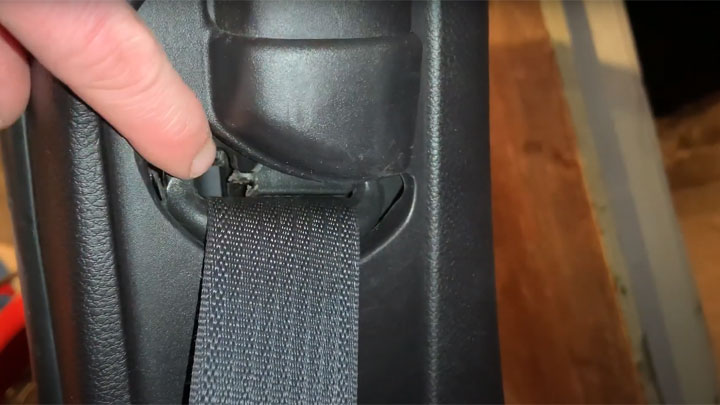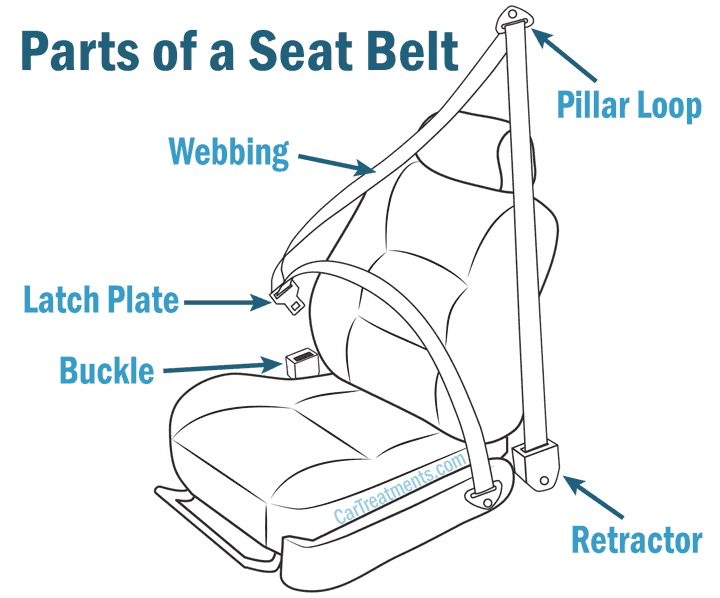How to Fix a Seat Belt That Won’t Retract (or Pull Out)
Is your seat belt jammed, stuck in place, and refuses to retract? Don’t stress. This quick car repair is easier than you think, and you’ll avoid the nuisance and safety hazard of a seat belt that just dangles loose.
Read on to learn how to diagnose and fix a seat belt that won’t retract or pull out.

How to Fix a Seat Belt That Won’t Retract
One of the most commonly experienced of all seat belt related issues is that of a seat belt that will not retract, or that has been pulled too far out and locked.
There are two probable causes of such issues; a twisted seat belt, or a malfunctioning retractor. In the event of a malfunctioning seal belt retractor, replacement is advised.
While it is possible to use a seat belt repair service such as MyAirbags.com or SafetyRestore.com to restore a retractor’s functionality, it is important to remember that you are dealing with safety-sensitive equipment, and such repairs are best completed by a trained technician.
Luckily, the root cause of a sagging seat belt or seat belt that fails to retract is often simply the result of twisted webbing. When this occurs, follow the steps below to restore the unit’s functionality.
Related: How to Fix a Car Door That Won’t Latch
#1 – Create Free-Play

Begin by unbuckling your seat belt, thereby creating slack in the unit’s webbing. Slowly feed the seat belt backward, if possible, in an attempt to allow 1”-2” of retraction.
#2 – Slowly Pull Seat Belt
Now, slowly pull your seatbelt outward, until it is fully extended. This should clear any webbing twists that are present. If you feel any resistance during this step, a twisted belt likely is to blame.
#3 – Study Belt for Signs of Twist
As you continue to pull your seat belt outward, look for signs of twisting in areas of low clearance. Pay close attention to the seat belt’s pillar loop, or any location where the seat belt disappears behind trim paneling.
#4 – Remove Paneling if Necessary
If you noticed outward resistance when completing the steps listed above, but have been unable to remedy the issue at hand, it might be necessary to remove any pillar trim that shrouds your seatbelt’s components.
This will allow you to physically check for obvious twists or other irregularities.
How to Fix a Seat Belt That Won’t Pull Out

Another commonly encountered restraint system issue is that which pertains to a seatbelt that will not pull out, leaving motorists unable to secure themselves into their vehicle.
This is also an issue that can have multiple root causes, including a faulty or damaged retractor.
However, before a retractor is condemned and replacement is initiated, one can attempt a simple fix, which often provides a satisfactory resolution. Doing so is as easy as following the steps below.
#1 – Create Slack if Possible
In the case of a seat belt that will not pull out, an obstruction of some type within the belt’s retractor is often to blame. To remedy this issue, begin by manually feeding your seatbelt back into its retractor to create slack.
#2 – Look for Obstructions
You will now study your seat belt’s retractor, in a bid to uncover any obstructions which might be causing the issue at hand. In some cases, you might have to remove pieces of trim paneling in order to gain access to this retractor.
Dirt, gravel, or any other type of debris can lead to retractor issues and must be cleared to provide optimal functionality.
#3 – Eliminate Twists
If your inspection reveals signs of a twisted seat belt, you must eliminate this issue to restore full functionality. Doing so often requires an individual to manually turn their retractor inward, thereby creating additional slack.
A flat head screwdriver can then be used to rectify any twisting that has occurred.
#4 – Test and Tug
You will now test your seat belt to see if it is able to be pulled outward. If problems persist, you can attempt to jar lose any internal binding that has taken place within the seat belt’s retractor.
This is done by firmly grabbing the seat belt’s webbing, and giving 2-3 swift, forceful tugs. In many instances, doing so will often free up bound or misaligned retractor components, thereby restoring functionality.
See Also: Common Causes of an Airbag Light Coming On
Other Seat Belt Problems

There are also several other seat belt related issues that all too often plague motorists and their vehicles. The following are some of the most common of these problems.
Slowly Retracting Seat Belt
Motorists are often faced with a seat belt that is slow to retract. A kinked or twisted seat belt is often to blame.
When this occurs, slowly pull outward on your seatbelt until it is fully extended, while checking for the presence of twist. Then, slowly allow the belt to retract to its rest position.
In some cases, an aging seat belt that has become stiff from contamination with dirt and other particles can be to blame for slow retraction. To remedy such issues, the seat belt in question can be pulled outward and cleaned with soapy water.
Sticking Seat Belt Release
With time, a seat belt buckle’s release button can become increasingly difficult to depress. This can be frustrating, to say the least, and is a common cause of concern for many motorists.
While the internal mechanical failure of a seat belt buckle does occur on occasion, one is far more likely to encounter a buckle that has become contaminated with dirt, sticky substances, and other forms of debris.
In order to remedy such concerns, rubbing alcohol or electrical contact cleaner can be used to wash away contaminant deposits. Cleaning a buckle in this manner takes only minutes, and often restores full functionality.
Parts of a Seat Belt

While a seat belt often appears rather simple in design to the casual observer, such units are made up of several individual components, which operate cohesively to keep a vehicle’s occupants safe.
The following are the five individual components that comprise a vehicle’s restraint system.
Buckle
A seat belt’s buckle serves as the receptacle into which a restraint’s latch plate is secured. When fastening your seat belt, its latch plate snaps into the system’s buckle, where it is locked in place until manually released.
Latch Plate
A seat belt’s latch plate is capable of sliding up and down on a restraint’s webbing, and locks in place when inserted into its corresponding buckle. The latch plate is then released from its buckle when the unit’s buckle release is depressed.
Webbing
A seat belt’s webbing is often referred to as the “belt” by motorists, because it wraps around a vehicle’s occupant, and serves as a restraining device in the event of a collision. Seat belt webbing is made of polyester fibers, and is designed to withstand immense shock loads.
Pillar Loop
A seat belt’s pillar loop is affixed to the area over a motorist’s shoulder, and allows the webbing of a seat belt to be pulled out or retracted for proper fitment and comfort. Pilar loops often differ in design from one vehicle to the next and are typically manufacturer specific in nature.
Retractor
A seat belt’s retractor is responsible for the inward and outward distribution of webbing under normal operating conditions.
A retractor is also responsible for locking a seat belt’s webbing in a fixed position when it is yanked outward in an abrupt fashion, such as in the case of a collision. In most cases, a retractor will lock a seatbelt in place after an accident as well.
Related: Steering Wheel Locked Up While Driving? (What to Do)
- P0480 Code (Symptoms, Causes, and How to Fix) - Apr 19, 2024
- Car Temperature Gauge Stopped Working? (Here’s Why) - Apr 15, 2024
- Ignition Coil vs Coil Pack (What’s the Difference?) - Apr 8, 2024

My 2nd row seatbelt on my Toyota Sienna 2022 xle is fully extended and will not feed back into the retractor. I can’t even feed it manually.
Could the seat belt be twisted near the retractor? What happens if you pull the belt out a little ways and then feed it in slowly?
Sean, it is locked. Nothing happens when I twist it. I am not able to pull it out either. Thanks!
I’m not sure then. Has the vehicle ever been in the accident while that seat belt retractor was installed? It may just need replacement.
Driver seat belt on 2015 GMC Terrain is not retracting. It is completely pulled out. Not twisted. I have tried wiggling it around and pushing a small amount back in but it still won’t retract. How do I fix this? Do I need to order a seatbelt retractor? Does it have to have any programming?
There shouldn’t be any programming involved, as seat belts are mechanical devices. Was the vehicle involved in an accident? Could the seat belt be hung up on a piece of trim or something inside the B pillar?
Hi,
I have installed a set of brand new seat belts in my 1975 VW Kombi.
They are very stiff to pull out across the chest and connect. Is there a way to make it roll out easier.
These are brand new
Regards
Klaus
Middle seatbelt is stuck it will not retract no twist’s visible how can I fix it
Try tugging outward gently, then try to push it back in. Wiggle it back and forth like this a few times and see if that frees the mechanism.
My buckle won’t lock the seat belt plate… Any suggestions
The buckle may be dirty. This could interfere with the locking mechanism. Have you tried cleaning it?
My seat belt will not pull out at first. But if you drive for a couple of minutes, then it release and can be buckled. The car was in a crash and these are new belts. Sometimes, it release on 1st try. Seems there is no pattern. Happens to both front belts.
I have the exact same issue and cause. Have not gotten an answer in three years.
I have a 2018 Sonata. The back seat has 2 seats that fold down allowing you to access the truck area. There are 3 seatbelts. The one for the middle got crossed in front of the seat and is now wedged in a lock position not allowing me to free it. I have access to the retractor in the trunk, but I cannot get it to budge. No matter how I adjust the seat, I cannot get enough slack to gently pull and loosen the belt. So now the belt is preventing me from putting the seat down fully. Is there a way to release the retractor entirely and reset it? Any other suggestions?
I’m not sure I’m able to picture what’s going on with the seatbelt here. If you have a nice shop in the area, I bet you could bring the car by and they could retract that belt for free. Perhaps even a friend could figure it out; sometimes it takes a second set of eyes.
The Driver seatbelt in my Wifes car refuses to come out when the car is hot during the Summer months – it’s fine during the Winter! Any suggestions as to what the cause of this could be and how I’d go about resolving it?
Have you tried any of the suggestions in the article?
I have the same problem in cold weather. 1997 Suburban. Once the interior of the car is warm it works.
I can fix most issues on a car, including older automatic transmissions. I took apart the retractor and couldn’t figure out what was wrong.
Did you ever find a solution for the problem?
MY seat belts are locked, The car was in accident. Is it possible for me to fix myself?
Did the airbags deploy? I would check to see if you can find new seat belt assemblies, complete with the retractors, tongue, and webbing. If you can find new ones it might be something you could do yourself (since they probably just bolt onto the car). I would definitely take it to a shop if you have any doubts in your abilities.
My 2006 Town & Country driver side seat belt is fully retracted and I am not able to use it. There is no slack so I’m not even able to give it a tug.
Pull slowly and from different angles. You are more likely to free the retractor by pulling slowly. Seat belt retractors are designed to lock into place when they are pulled quickly, so a tug probably won’t help you free the seat belt.
My seat belt on my Kia Sorrento is locked will not retract and is locked in si tight there is no play in it at all. I did not wreck the car but the belt is locked as if it were. How can I fix this??
Are you able to pull the belt out more?
seat belt keeps jamming
Hey Brian, can you elaborate? Is the seat belt fully retracted?
My seat belt tightened and will not release what might cause this, I own a Chevrolet Silverado 15
Is the seat belt buckled or is it fully retracted?
If the seat belt is pulled out, you have to let it fully retract before you can pull it out farther.
My seatbelt is fully out and it’s managed to twist at the top where belt goes into. It won’t extend anyone I’ve tried to untwist it but it’s tight
You should have enough clearance to untwist it where the belt retracts, but it will take a bit of maneuvering and perhaps finger strength to slide the belt past itself in that narrow space.
Did you get it fixed? Mine is doing the same thing
My seatbelt won’t come out